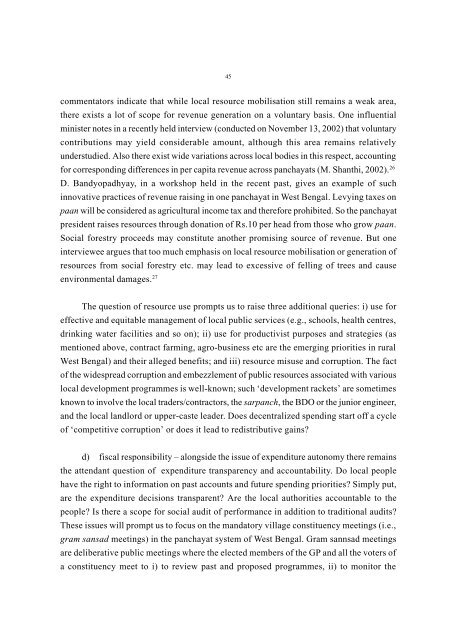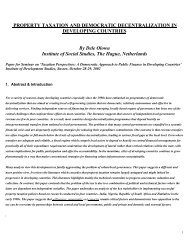View Article - Institute of Development Studies
View Article - Institute of Development Studies
View Article - Institute of Development Studies
You also want an ePaper? Increase the reach of your titles
YUMPU automatically turns print PDFs into web optimized ePapers that Google loves.
45commentators indicate that while local resource mobilisation still remains a weak area,there exists a lot <strong>of</strong> scope for revenue generation on a voluntary basis. One influentialminister notes in a recently held interview (conducted on November 13, 2002) that voluntarycontributions may yield considerable amount, although this area remains relativelyunderstudied. Also there exist wide variations across local bodies in this respect, accountingfor corresponding differences in per capita revenue across panchayats (M. Shanthi, 2002). 26D. Bandyopadhyay, in a workshop held in the recent past, gives an example <strong>of</strong> suchinnovative practices <strong>of</strong> revenue raising in one panchayat in West Bengal. Levying taxes onpaan will be considered as agricultural income tax and therefore prohibited. So the panchayatpresident raises resources through donation <strong>of</strong> Rs.10 per head from those who grow paan.Social forestry proceeds may constitute another promising source <strong>of</strong> revenue. But oneinterviewee argues that too much emphasis on local resource mobilisation or generation <strong>of</strong>resources from social forestry etc. may lead to excessive <strong>of</strong> felling <strong>of</strong> trees and causeenvironmental damages. 27The question <strong>of</strong> resource use prompts us to raise three additional queries: i) use foreffective and equitable management <strong>of</strong> local public services (e.g., schools, health centres,drinking water facilities and so on); ii) use for productivist purposes and strategies (asmentioned above, contract farming, agro-business etc are the emerging priorities in ruralWest Bengal) and their alleged benefits; and iii) resource misuse and corruption. The fact<strong>of</strong> the widespread corruption and embezzlement <strong>of</strong> public resources associated with variouslocal development programmes is well-known; such ‘development rackets’ are sometimesknown to involve the local traders/contractors, the sarpanch, the BDO or the junior engineer,and the local landlord or upper-caste leader. Does decentralized spending start <strong>of</strong>f a cycle<strong>of</strong> ‘competitive corruption’ or does it lead to redistributive gains?d) fiscal responsibility – alongside the issue <strong>of</strong> expenditure autonomy there remainsthe attendant question <strong>of</strong> expenditure transparency and accountability. Do local peoplehave the right to information on past accounts and future spending priorities? Simply put,are the expenditure decisions transparent? Are the local authorities accountable to thepeople? Is there a scope for social audit <strong>of</strong> performance in addition to traditional audits?These issues will prompt us to focus on the mandatory village constituency meetings (i.e.,gram sansad meetings) in the panchayat system <strong>of</strong> West Bengal. Gram sannsad meetingsare deliberative public meetings where the elected members <strong>of</strong> the GP and all the voters <strong>of</strong>a constituency meet to i) to review past and proposed programmes, ii) to monitor the





